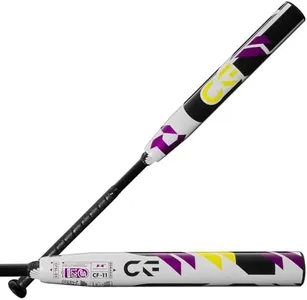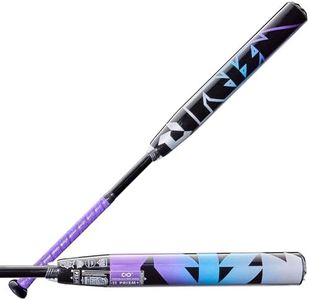10 Best Softball Bats 2026 in the United States
Our technology thoroughly searches through the online shopping world, reviewing hundreds of sites. We then process and analyze this information, updating in real-time to bring you the latest top-rated products. This way, you always get the best and most current options available.

Our Top Picks
Winner
Easton | 2026 | Ghost Advanced Fastpitch Softball Bat | Approved for All Fields | -10 Drop | 34 Inch
Most important from
62 reviews
The Easton 2026 Ghost Advanced Fastpitch Softball Bat is a composite bat designed for serious players who want performance and comfort. Its 34-inch length and 24-ounce weight (noted as a -10 drop) make it a good fit for fastpitch softball players, balancing power and control. The double barrel construction and Sonic Comp Max composite material contribute to a large sweet spot and a distinctive 'pop' sound, which means better hits and satisfying feedback.
The two-piece Connexion Evolution design reduces vibration and improves energy transfer, so swings feel smoother and less jarring on the hands. The Power Boost soft knob adds comfort and leverage for the bottom hand, helping reduce fatigue during games. The bat is approved for multiple leagues including USA, USSSA (fastpitch only), NSA, ISA, and WBSC, making it versatile for different competitive levels.
One downside is that the grip is the standard polyurethane type, which may wear faster or feel less cushioned compared to premium grips. Also, the composite material may require a break-in period before reaching peak performance. This bat is a solid choice for players of all skill levels, especially those who want a lightweight but powerful option that meets official league regulations. However, if you prefer an aluminum bat or need a heavier weight, this might not fit your needs.
Most important from
62 reviews
Easton | Ghost Unlimited Fastpitch Softball Bat | -10 | 32"
The Easton Ghost Unlimited Fastpitch Softball Bat is a high-performance 32-inch composite bat designed primarily for advanced fastpitch players, especially women. Its standout feature is the 1-inch longer Double Barrel EXT design, which gives a larger sweet spot, making it easier to make solid contact. The composite material, Sonic Comp Max, is Easton's most durable and offers a great balance of power and feel, with a distinctive sound on hits. Weighing 21 ounces with a -10 drop, this bat is on the lighter side, allowing for quicker swings and better control without sacrificing strength.
The VRS1 internal connection reduces weight towards the handle and minimizes vibration, helping to reduce sting on mishits. The Flow-Tack grip is soft and tacky, enhancing control and comfort during play. As a composite bat, it may require a break-in period before reaching peak performance, and its price might be higher than more basic aluminum or hybrid models. Its length and weight make it better suited for players with some experience rather than beginners.
This bat meets league regulations for fastpitch and offers a reliable one-year warranty. For advanced players seeking a durable, comfortable bat with a large sweet spot and excellent vibration reduction, the Easton Ghost Unlimited is a compelling option.
Marucci, Asura Fastpitch Softball Bat, Composite, -10 Drop, Mint, 32" / 22 oz
Most important from
27 reviews
The Marucci Asura Fastpitch Softball Bat is a composite bat designed for advanced players, especially women teens and adults. It measures 32 inches in length and weighs 22 ounces, which is a balanced size for good control and swing speed. Its composite material, enhanced by Marucci's EVolve technology, offers a sturdy yet responsive feel, helping to deliver consistent hits. The barrel uses Gap Sync technology combined with the OLS Connection system, which reduces unwanted vibrations and promotes a smooth, stable swing—important for comfort and better ball contact.
One notable feature is the player's optimized handle with a micro-perforated, soft-touch grip that's comfortable and helps with control during swings. The True Flex Endcap allows more barrel flex at the end, making the bat more forgiving on off-center hits. This bat meets the regulations for major competitive leagues like WBSC, USSSA, and others, so it can be confidently used in official fastpitch games. A possible drawback is its -10 drop weight (difference between length and weight), which might feel a bit heavy for younger or less experienced players seeking faster swing speeds. Also, while composite bats generally require a break-in period, this model's advanced composite construction helps minimize that. The mint color is unique but a matter of personal preference. If you’re an advanced fastpitch player looking for a high-quality, league-approved bat with comfort features and stable performance, the Marucci Asura is a strong choice. However, beginners or those needing a lighter bat might want to explore other options.
Most important from
27 reviews
Buying Guide for the Best Softball Bats
Choosing the right softball bat can significantly impact your performance and enjoyment of the game. It's important to consider various factors to ensure you select a bat that suits your playing style, skill level, and league requirements. Here are some key specifications to consider when picking a softball bat and how to navigate them to find the best fit for you.FAQ
Most Popular Categories Right Now




















